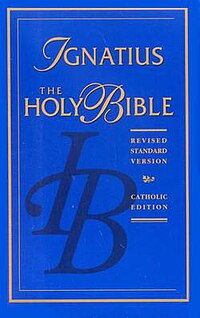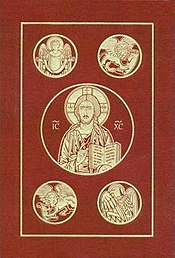| RSV-Catholic Edition | |
|---|---|
 | |
| Full name | Revised Standard Version-Catholic Edition |
| Abbreviation | RSV-CE |
| OT published | 1966 |
| NT published | 1965 |
| Derived from | Revised Standard Version |
| Textual basis | Same as the Protestant RSV |
| Translation type | Literal |
| Version revision | 2006 |
| Copyright | Copyrighted 1946, 1952, 1957, 1965, 1966, 2006 by the Division of Christian Education of the National Council of the Churches of Christ in the USA |
(({genesis1:1))}
(({john3:16))} | |
The Revised Standard Version Catholic Edition (also known as the RSV-CE) is an English-language adaptation of the Revised Standard Version (RSV) of the Bible for use by Catholics. It is widely used by conservative Catholic scholars and theologians, and is accepted as one of the most accurate and literary Bible translations suitable for Catholic use.
The RSV-CE, sometimes called the Ignatius Bible (after its primary publisher), was published in the following stages:
- New Testament (1946, originally copyrighted to the International Council of Religious Education)
- Old Testament (1952)
- Deuterocanonical Books (1957)
- Catholic Edition of the New Testament (1965)
- Catholic Edition of the Old Testament incorporating the deuterocanonicals (1966)
- Second Catholic Edition (Ignatius Edition) (2006)
Background
The Revised Standard Version (RSV) stands within the tradition of the Authorized King James Version, which was updated in 1885 in the UK as the Revised Version, with an American edition known as the American Standard Version published in 1901. The latter version was revised in 1952 by a Standard Bible Committee authorized by the National Council of Churches; this was known as the Revised Standard Version. A revision of the Apocrypha was authorized in December of that year, and would be completed in 1957.
The 1943 encyclical of Pope Pius XII, Divino afflante Spiritu, encouraged the translation of Catholic Bible from the original languages instead of the Vulgate alone, as had been the tradition since the Council of Trent. "It was in fact with a view to filling this rather obvious gap in the shortest possible time that some Catholic scholars considered the possibility of so editing the Revised Standard Version, on its appearance in 1952, as to make it acceptable to Catholic readers."[1] In 1954, after a year of negotiations, the Standard Bible Committee granted the Catholic Biblical Association of Great Britain permission to print a Revised Standard Version Catholic Edition (RSV-CE) Bible. Originally, the RSV-CE New Testament was to have been issued as early as 1956, but Cardinal Griffin, who had approved the plan, died before he could give it an imprimatur. A delay of nearly a decade ensued before Archbishop Gray of St. Andrews and Edinburgh gave the RSV-CE New Testament the necessary imprimatur. And so at last, in 1965, the RSV-CE New Testament was published.[2] In the following year, 1966, the full RSV-CE Bible was published, with the deuterocanonical works incorporated into the Old Testament text. The Prayer of Manasseh, 1 Esdras, 2 Esdras, 3 Maccabees, 4 Maccabees and Psalm 151 were omitted from the RSV-CE, as they are not part of Catholic canon.
Although a New Revised Standard Version Catholic Edition was published in 1989, the mechanical use of inclusive language did not find favour amongst many scholars, and the use of such language for Bible translations was specifically rejected by the Catholic hierarchy. A second edition of the RSV-CE was negotiated with the National Council of Churches, and issued by Ignatius Press in 2006.
Considerations for a Catholic edition
A Catholic Bible differs in the number, order, and occasionally preferred emphasis than books typically found in Bibles used by Protestants. The Catholic Church "from the very beginning accepted as her own that very ancient Greek translation of the Old Testament which is called the septuagint, whereas translations used by Protestants typically use the shorter Masoretic Text as their basis.[3] The editors' stated aim for the RSV Catholic Edition was "to make the minimum number of alterations, and to change only what seemed absolutely necessary in the light of Catholic tradition."[4]
The RSV-CE was based on the 1962 printing of the RSV (see Revised Standard Version Later Editions). Making no changes to the Old Testament translation itself, the editors merely included the seven Deuterocanonical works in their traditional Catholic order, adding an appendix of explanatory and interpretive notes. The Psalms preserved the "Protestant" numbering of the RSV (which reflects the Hebrew system), accompanying it with the Catholic numbering system (based upon the Greek Septuagint and the Latin Vulgate) in brackets.
Some minor changes were made to New Testament texts where variant readings aligned with Catholic understanding and tradition. An appendix to the RSV Catholic Edition documented its departures from the 1962 RSV New Testament. Some of the more important changes were:
- the use of the phrase "full of grace" in the angel's greeting to Mary (Luke 1:28)
- the restoration of the story of the woman caught in adultery (John 7:53-8:11)
- the inclusion of the longer ending to the Gospel according to Mark (16.9-20).
Some disputed verses or phrases that had been footnoted in the RSV were restored in the Catholic Edition (Luke 22.19-20; 24. 5, 12, 36, 40, 51-52). Footnotes regarding the value of New Testament coins were rewritten in terms of how long it took the average worker to earn the money (e.g. the denarius was no longer defined as "twenty cents" but as "a day's wage"). The book of Revelation, called "The Revelation To John", had added as a subtitle ("The Apocalypse"). Some of the changes made in the RSV Catholic Edition were later introduced into the RSV Second Edition of the New Testament in 1971 in preparation for the issuance of the RSV Common Bible.
Modern use and Second Edition
When the New Revised Standard Version (NRSV) was released in 1989, the original RSV-CE went out of print. Traditional Christians, both Catholic and Protestant, as well as Biblical scholars criticized the NRSV's wide use of gender-inclusive language that often reflected a dynamic rendering of the underlying text over a literal one.[5] Because of its significance in the development of the English Bible tradition, many publishers and Biblical scholars continue to rely on the RSV tradition in their work, especially when writing for mixed audiences:
- [T]he Revised Standard Version of 1946-1957 was becoming established and, in 1966, was accepted by Catholics and Protestants as a 'Common Bible'. It was the first truly ecumenical Bible and brought together the two traditions – the Catholic Douay-Rheims Bible and the Protestant Authorised Version.[6]
Ignatius Press, in particular, revived interest the RSV-CE in 1994, selecting it as the basis of its "Ignatius Bible." Today, the original 1966 edition of the RSV-CE is still published by Ignatius Press, Scepter Publishers, Oxford University Press, Saint Benedict Press, and by Asian Trading Corporation in India.[7]
RSV Second Catholic Edition (RSV-2CE)

In early 2006, Ignatius Press released the Revised Standard Version, Second Catholic Edition (RSV-2CE). This second edition of the "Ignatius Bible" removed archaic pronouns (thee, thou) and accompanying verb forms (didst, speaketh), revised passages used in the lectionary according to the Vatican document Liturgiam authenticam, and elevated some passages out of RSV footnotes when they favored Catholic renderings. For instance, the RSV-2CE:
- Renders Isaiah 7:14's "almah" as "virgin" (as opposed to the RSV's original "young woman") in keeping with Catholic and Protestant tradition pointing to this verse as an anticipation of the role of The Virgin Mary in the birth of Christ.
- Prefers a reading of Psalm 139[138].14 – grammatically challenging and difficult to translate – that underscores the Catholic teaching opposing abortion:
- "I praise you, for I am wondrously made. Wonderful are your works! You know me right well..."
- The verse read (and still reads in the 1977 edition of the RSV):
- "I praise thee, for thou art fearful and wonderful. Wonderful are thy works! Thou knowest me right well..."
- Substitutes "mercy" for "steadfast love" (translated from the Hebrew hesed) throughout the Psalms.[8]
The Second Catholic Edition also features new typesetting, section headings, and maps. As was the case with the original RSV, gender-neutral language is not used when it has no direct referent in original language of the text.
The title page states that the RSV Second Catholic Edition "was revised according to Liturgiam authenticam, 2001" and that it was "approved under the same [i.e. 1966] imprimatur by the Secretariat for Doctrine and Pastoral Practices, National Council of Catholic Bishops, February 29, 2000." To that end, Ignatius Press submitted its proposed revisions to the United States Conference of Catholic Bishops and to the Congregation for Divine Worship, making specifically-requested changes to those portions of the text in liturgical use as lectionary readings.[9]
The RSV-2CE Bible is currently available in various print editions from Ignatius Press, as a New Testament volume from Lighthouse Catholic Media, and electronically as a popular study Bible app from both. As with the original RSV and its first Catholic edition, the copyright remains in the hands of the National Council of Churches.
Liturgical use and endorsements
The Revised Standard Version, Second Catholic Edition is emerging as a popular study and devotional Bible for Catholic scholars and laity with an appreciation for the formal equivalence approach to the translation. The English translations of the works of Cardinal Joseph Ratzinger (now Pope Emeritus Benedict XVI) typically cite Biblical texts from the RSV-CE or its Second Edition, and many Catholic commentators, authors, and scholars use it as well, including Scott Hahn, Curtis Mitch, Steve Ray, Jimmy Akin.[10]
Although "the revised Lectionary, based on the New American Bible is the only English-language Lectionary that may be used at Mass" in the United States,[11] the Revised Standard Version, Second Catholic Edition has been approved for liturgical use in Anglican Use Catholic parishes of the U.S. Pastoral Provision and Personal Ordinariates for former Anglicans around the world. To that end, Ignatius Press has published a lectionary based on the RSV-2CE, approved for use by the Episcopal Conference of the Antilles and by the Congregation for Divine Worship and the Discipline of the Sacraments for use in the personal ordinariates. The Personal Ordinariate of Our Lady of Walsingham in the United Kingdom has adopted the RSV-2CE as "the sole lectionary authorized for use" in its liturgies.[2]
See also
English language Bibles approved for Catholics
- Confraternity Bible
- Douay-Rheims Bible
- Good News Bible / Today's English Version - Catholic Edition
- Jerusalem Bible
- Knox Bible
- New American Bible
- Revised Standard Version Catholic Edition
- New Revised Standard Version Catholic Edition
- Revised Standard Version, Second Catholic Edition (Ignatius Bible)
References
- ^ Revised Standard Version, Second Catholic Edition, "Introduction to the 1966 Edition"
- ^ Reginald C. Fuller, gen. ed. A New Catholic Commentary on Holy Scripture. London: Nelson, Ltd.; 1969
- ^ "Dogmatic Constitution on Divine Revelation, Dei Verbum". Vatican: Vatican. Retrieved 2015-01-21.
- ^ Revised Standard Version, Second Catholic Edition, "Introduction to the 1966 Edition"
- ^ Inclusive Language: Is It Necessary? | http://www.catholicculture.org/culture/library/view.cfm?id=2623
- ^ Mgr Andrew Burnham: The Customary of Our Lady of Walsingham | http://www.ordinariate.org.uk/news/OrdinariateNews.php?Mgr-Andrew-Burnham-The-Customary-of-Our-Lady-of-Walsingham-121
- ^ http://www.mangalorean.com/news.php?newstype=local&newsid=199297
- ^ http://umsis.miami.edu/~medmunds/RSVCEdiff.htm
- ^ Ecclesiastical Approval of the RSV-2CE Bible | url=http://www.ewtn.com/vexperts/showmessage.asp?number=490955
- ^ See any book by Hahn (ICSB, The Lamb's Supper, Reasons to Believe), Mitch (ICSB, CCSS [NAB], A Study Guide for Jesus of Nazareth), Jimmy Akin (Fathers Know Best, Salvation Controversy), title pages: "All quotations of Scripture in this book are taken from the Revised Standard Version - [Second] Catholic Edition unless otherwise noted".
- ^ [1]
External links
- Revised Standard Version Catholic Edition, online text
- United States Conference of Catholic Bishops
- Vatican
- Template:Wayback
- Extensive review of the RSV
- StudyLight.org Online bible versions includes the RSV
- RSV-CE on EWTN